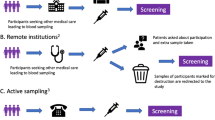Abstract
Multiple myeloma (MM) is twice as common among Blacks than Whites in the United States. The reasons for this racial disparity are unknown, and the etiology of this cancer in general, is poorly understood. Repeated or chronic antigenic stimulation (CAS) of the immune system has been suggested as a risk factor. Previous case-control studies have reported inconsistent CAS associations based on evaluations of individual and biologic categories of medical conditions. Interview data from 573 cases and 2,131 population-based controls were used to investigate further the CAS hypothesis using an immunologically based approach, and to determine whether CAS accounts for the excess of myeloma among Blacks. Over 50 medical conditions were grouped into biologically and immunologically related categories, and B-cell-and T-cell-mediated response groups. Except for urinary tract infections among Black men (odds ratio [OR]=2.0), no significantly increased risks of MM were observed. However, there was a suggestion of increased risk among Blacks with an increased exposure to anaphylatic conditions. Analysis by immunoglobulin type revealed significantly elevated risks of IgG myeloma with eczema (OR=2.1), the biologic category ‘allergic conditions” (OR=1.6), and the immunologic category ‘anaphylaxis response’ (OR=1.6) among Whites, with Blacks having slightly lower risks. Our findings do not support a causal relationship between CAS and MM, nor do they explain the higher incidence among Blacks.
Similar content being viewed by others
References
Miller BA, Ries LAG, Hankey BF, et al.SEER Cancer Statistics Review 1973–90. Washington, DC: US Government Printing Office, 1993; NIH Pub. No. 93-2789.
Dameshek W, Schwartz RS. Leukemia and auto-immunization-some possible relationships.Blood 1959;14: 1151–8.
Potter, M. The plasma cell tumors and myeloma proteins of mice. In: Busch H, ed.Methods in Cancer Research, Vol. 2 New York, NY (USA): Academic Press, 1967: 105–57.
Potter M. Plasmacytomas in mice.Semin Oncol 1986;13: 275–81.
Radl J, Croese JW, Zurcher C, van den Enden-Vieveen MHM, Leeuw AW. Animal model of, human disease: multiple myeloma.Am J Pathol 1988;132: 593–7.
Osserman EF, Takatsuki K. Considerations regarding the pathogenesis of the plasmacytic dyscrasias.Ser Haematol 1965;4: 28–49.
Imahori S, Moore GE. Multiple myeloma and prolonged stimulation of reticuloendothelial system.NY State J Med 1972;72: 1625–8.
Woodroofe AJ. Multiple myeloma associated with long history of hyposensitization with allergen vaccines.Lancet 1972;i: 9.
Isobe T, Osserman EF. Pathologic conditions associated with plasma cell dyscrasias: a study of 806 cases.Ann NY Acad Sci 1971;190: 507–18.
Penny R, Hughes S. Reported stimulation of the reticuloendothelial system and the development of plasma-cell dyscrasias.Lancet 1970;i: 77–8.
Rosenblatt J, Hall CA. Plasma-cell dyscrasia following prolonged stimulation of reticuloendothelial system.Lancet 1970;i:301–2.
Gallagher RP, Spinelli JJ, Elwood JM, Skippen DH. Allergies and agricultural exposure as risk factors for multiple myeloma.Br J Cancer 1983;48: 853–7.
Pearce NE, Smith AH, Howard JK, Sheppard RA, Giles HJ, Teague CA. Case-control study of multiple myeloma and farming.Br J Cancer 1986;54: 493–500.
Cohen HJ, Bernstein RJ, Grufferman S. Role of immune stimulation in etiology of multiple myeloma: a case-control study.Am J Hematol 1987;24: 119–26.
Koepsell TD, Daling JR, Weiss NS, et al. Antigenic stimulation and the occurrence of multiple myeloma.Am J Epidemiol 1987;126: 1051–62.
Linet MS, Harlow SD, McLaughlin JK. A case-control study of multiple myeloma in whites: chronic antigenic stimulation, occupation, and drug use.Cancer Res 1987;47: 2978–81.
Cuzick J, De Stavola B. Multiple myeloma—a case-control study.Br J Cancer 1988;57: 516–20.
Boffetta P, Stellman SD, Garfinkel L. A case-control study of multiple myeloma nested in the American Cancer Society prospective study.Int J Cancer 1989;43: 554–9.
Williams AR, Weiss NS, Koepsell TD, Lyon JL, Swanson GM. Infectious and noninfectious exposures in the etiology of light chain myeloma: a case-control study.Cancer Res 1989;49: 4038–41.
Gramenzi A, Buttino, I, D'Avenzo B, Negri E, Franceschi S, La Vecchia C. Medical history and the risk of multiple myeloma.Br J Cancer 1991;63: 769–72.
Doody MM, Linet MS, Glass AG, et al. Leukemia, lymphoma and multiple myeloma following selected medical conditions.Cancer Causes Control 1992;3: 449–56.
Eriksson M. Rheumatoid arthritis as a risk factor for multiple myeloma: a case-control study. In: Eriksson M, ed.Epidemiological Studies on Multiple Myeloma. Umea, Sweden: University of Sweden, 1992: 99–113.
Herrinton LJ, Demers PA, Koepsell TD, et al. Epidemiology of the M-component immunoglobulin types of multiple mycloma.Cancer Causes Control 1993;4: 83–92.
Waksberg J. Sampling methods for random digit dialing.J Am Stat Assoc 1978; 40–6.
Lawrence RC, Hochberg MC, Kelsey JL, et al. Estimates of the prevalence of sclected arthritic and musculoskeletal diseases in the United States.J Rheumatol 1989;16: 427–41.
Engelman L. Stepwise logistic regression. In: Dixon WJ, ed.BMDP Statistical Software Manual, Vol. 2 Berkeley, CA (USA): University of California Press, 1990: 1013–46.
Epstein J, Hata H. Multiple myeloma evolves from a malignant hematopoietic stem cell. In: Obrams I, Potter M eds:Epidemiology and Biology of Multiple Myeloma. Berlin-Heidelberg, Germany: Springer-Verlag, 1991: 143–6.
Linet MS, Harlow SD, McLaughlin JK, McCaffrey LD. A comparison of interview data and medical records for previous medical conditions and surgery.J Clin Epidemiol 1989;42: 1207–13.
Author information
Authors and Affiliations
Additional information
This research was funded under comtracts NO1-CP-51090, NO1-CN-0522, NO1-CP-51089, NO1-CN-31022, NO1-CP-51092, NO1-CN-05227 from the US National Cancer Institute.
Rights and permissions
About this article
Cite this article
Lewis, D.R., Pottern, L.M., Brown, L.M. et al. Multiple myeloma among blacks and Whites in the United States: the role of chronic antigenic stimulation. Cancer Causes Control 5, 529–539 (1994). https://doi.org/10.1007/BF01831381
Received:
Accepted:
Issue Date:
DOI: https://doi.org/10.1007/BF01831381




